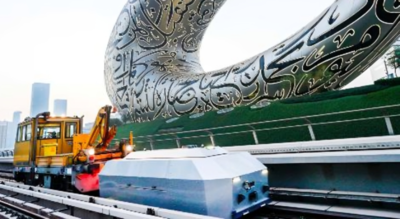
ARIIS, Dubai Metro’s new AI robot, uses LiDAR and 3D imaging to inspect tracks without disrupting operations, cutting manual work by 1,700 hours/ Image: RTA Dubai
In a major technological breakthrough for urban transportation, Dubai’s Roads and Transport Authority (RTA) has officially introduced an AI-powered robotic system to inspect and monitor the Dubai Metro's rail tracks and related infrastructure. The robotic platform, named ARIIS, short for Automated Rail Infrastructure Inspection System, was announced on Thursday as part of RTA’s latest move to enhance operational efficiency, ensure safer operations, and maintain Dubai Metro’s position as one of the most advanced urban rail systems globally.
From 2,400 to 700 Man-Hours: Efficiency Gets a 75% Boost
According to the RTA, the deployment of ARIIS enables a dramatic reduction in human labour. Traditionally, conducting full-scale inspections of Dubai Metro’s extensive rail infrastructure required approximately 2,400 man-hours by human personnel.
With ARIIS in operation, this number can be slashed to just 700 man-hours, delivering a 75% increase in operational efficiency. In practical terms, this means:
- Faster inspection cycles, enabling the rail network to be checked more frequently and more thoroughly.
- Reduction in manual inspections by up to 70%, minimising human error and safety risks.
- A 40% improvement in assessing infrastructure conditions, thanks to the system’s advanced sensor and imaging technologies.
This leap in efficiency not only saves time and resources, but also strengthens system reliability by proactively detecting issues before they impact service.
What Is ARIIS and How It Works
ARIIS is equipped with a suite of advanced technologies designed to function autonomously and without disrupting regular metro operations. These include:
- LiDAR (Light Detection and Ranging) sensors: to measure distances with laser precision and create 3D maps of the rail environment.
- High-resolution lasers: for scanning surface integrity of rails and other components.
- 3D cameras: that offer comprehensive imaging of track infrastructure.
This system navigates the tracks and continuously collects data on rail alignment, wear, vibrations, and structural anomalies.
It allows for real-time analysis and long-term condition monitoring, enabling predictive and proactive maintenance strategies, a feature RTA has emphasised as critical for improving lifecycle performance and reducing emergency repairs.Also read: World’s highest metro station to be built on Dubai’s new blue line
Top Stakeholders Endorse ARIIS for Efficiency Gains
The announcement was accompanied by strong endorsements from senior figures at both RTA and Dubai Metro’s operating company, Keolis MHI.Speaking to Khaleej Times, Abdul Mohsin Kalbat, CEO of RTA’s Rail Agency, expressed pride in Dubai’s leadership in transport innovation: “Dubai is proud to lead in smart solutions to improve reliability and efficiency of Dubai Metro.
The introduction of ARIIS represents another significant leap in our journey to maintain our Metro as one of the most advanced and safest public transportation networks globally,” Kalbat said. Echoing this sentiment, David Franks, Managing Director of Keolis MHI, the operating company of Dubai Metro, highlighted how ARIIS changes the maintenance paradigm: “ARIIS is a milestone achievement, significantly transforming our maintenance operations by improving safety, efficiency, and data-driven decision-making,” Franks said. With ARIIS now in operation, Dubai sets a new regional standard in automated rail maintenance, aligning seamlessly with its smart city ambitions.Read more: All You Need to Know About Dubai Metro’s Blue Line: Route, Timings, Capacity

 1 day ago
48
1 day ago
48




























 English (US)
English (US)